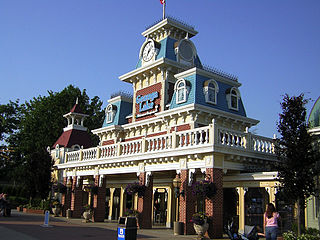
Geauga Lake was an amusement park in Bainbridge Township and Aurora, Ohio. It was established in 1887, in what had been a local recreation area adjacent to a lake of the same name. The first amusement ride was added in 1889, and the park's first roller coaster – the Big Dipper – was built in 1925. The park was sold to Funtime, Inc., in 1969 and was expanded over the years with additional rides and amenities. Funtime was acquired by Premier Parks in 1995, and for the 2000 season, they re-branded Geauga Lake as Six Flags Ohio, adding four new roller coasters. The following year, Six Flags bought the adjacent SeaWorld Ohio and combined the two parks under the name Six Flags Worlds of Adventure.

A wooden roller coaster is a type of roller coaster classified by its wooden track, which consists of running rails made of flat steel strips mounted on laminated wood. The support structure is also typically made of wood, but may also be made of steel lattice or truss, which has no bearing on a wooden coaster's classification. The type of wood often selected in the construction of wooden coasters worldwide is southern yellow pine, which grows abundantly in the southern United States, due to its density and adherence to different forms of pressure treatment.

Philadelphia Toboggan Coasters (PTC) is one of the oldest existing roller coaster manufacturing companies in the world. Based in Hatfield, Pennsylvania, it was established in 1904 by Henry B. Auchy and Chester Albright under the name Philadelphia Toboggan Company. The company manufactured carousels, wooden roller coasters, toboggans and later, roller coaster trains.

Playland, often called Rye Playland and also known as Playland Amusement Park, is an amusement park located in Rye, New York, along the Long Island Sound. Built in 1928, the 280-acre (110 ha) park is owned by the Westchester County government. Beginning in 2018 the park has been operated under contract by Standard Amusements.
The Santa Cruz Beach Boardwalk is an oceanfront amusement park in Santa Cruz, California. Founded in 1907, it is California's oldest surviving amusement park and one of the few seaside parks on the West Coast of the United States.
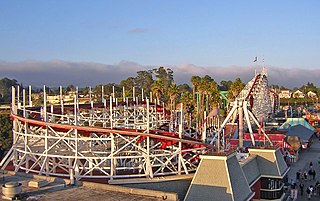
The Giant Dipper is a historic wooden roller coaster located at the Santa Cruz Beach Boardwalk, an amusement park in Santa Cruz, California. The Giant Dipper, which replaced the Thompson's Scenic Railway, took 47 days to build and opened on May 17, 1924, at a cost of $50,000. With a height of 70 feet (21 m) and a speed of 55 miles per hour (89 km/h), it is one of the most popular wooden roller coasters in the world. As of 2012, over 60 million people have ridden the Giant Dipper since its opening. The ride has received several awards such as being named a National Historic Landmark, a Golden Age Coaster award, and a Coaster Landmark award.
John A. Miller, born August John Mueller, was an American roller coaster designer and builder, inventor, and businessman. Miller patented over 100 key roller coaster components, and is widely considered the "father of the modern high-speed roller coaster." During his lifetime, he participated in the design of approximately 150 coasters and was a key business partner and mentor to other well-known roller coaster designers, including Harry C. Baker and John C. Allen.

The Allan Herschell Company was a company that specialized in the creation of amusement rides, particularly carousels and roller coasters. The company manufactured portable machines that could be used by traveling carnival operators. It was started in 1915 in the town of North Tonawanda, just outside Buffalo, New York, USA.

Big Dipper was a wooden roller coaster located at the defunct Geauga Lake amusement park in Bainbridge Township, Ohio. Originally opened in 1925 as Sky Rocket, it was renamed Clipper in the late 1940s, and eventually Big Dipper in 1969. It was the oldest operating roller coaster in Ohio and seventh-oldest in the United States when it closed in 2007. Designed by John A. Miller, the Big Dipper was also one of the last remaining roller coasters in the world from the designer. American Coaster Enthusiasts awarded the coaster its ACE Coaster Classic and ACE Coaster Landmark designations. Efforts to sell, preserve, and restore the ride were unsuccessful. The ride was demolished on October 17, 2016.

Playland was a 10-acre (40,000-square-meter) seaside amusement park located next to Ocean Beach, in the Richmond District at the western edge of San Francisco, California, along Great Highway, bounded by Balboa and Fulton streets. It began as a collection of amusement rides and concessions in the late 19th century, and was preceded by Chutes at the Beach, opened in 1921. Playland closed Labor Day weekend in 1972.

Chance Rides is a roller coaster and amusement ride manufacturer. Originally founded in 1961, the current company was formed on May 16, 2002, when the former Chance Industries Inc. emerged from bankruptcy. The main office and manufacturing facility are located in Wichita, Kansas.

Charles I. D. Looff was a Danish master carver and builder of hand-carved carousels and amusement rides, who immigrated to the United States of America in 1870. Looff built the first carousel at Coney Island in 1876. During his lifetime, he built over 40 carousels, several amusements parks, numerous roller coasters and Ferris wheels, and built California's famous Santa Monica Pier. He became famous for creating the unique Coney Island style of carousel carving.
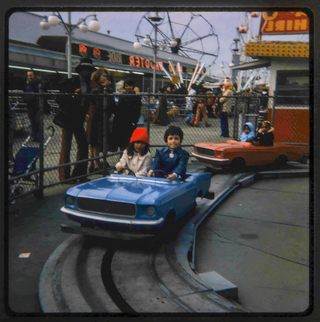
Rockaways' Playland was an amusement park that operated from 1902 to 1987 in Rockaway Beach in Queens, New York City. Bounded by Beach 97th and Beach 98th Streets between Rockaway Beach Boulevard and the Rockaway Beach and Boardwalk, Rockaways' Playland was created in 1902 by roller coaster designer LaMarcus Adna Thompson. By 1903 a ferry dock was added not far from the park, making it more convenient to reach than some of the competing amusement parks. The park was sold in 1927 to Robert Katlin, who added amenities such as a gym and swimming pool, and the following year to A. Joseph Geist, who achieved greater success than the previous owners. Between 1928 and 1970, Rockaways' Playland was extremely successful, drawing 175 million visitors. It closed in 1987 due to a sharp increase in the price of insurance.
Krug Park was an amusement park located at 2936 North 52nd Street in the Benson neighborhood of Omaha, Nebraska, United States at the turn of the 20th century. In 1930, Krug Park was the site of the worst roller coaster accident in the nation up to that time.
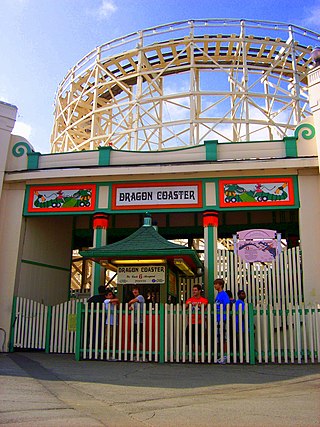
The Dragon Coaster is a wooden roller coaster at Playland amusement park in Rye, New York. Opened in 1929, it was designed and built by amusement ride creator Frederick Church, the co-inventor of the Racing Derby, another early 20th century amusement park ride. The Dragon Coaster has approximately 3,400 feet of track and is, at its highest, approximately 80 feet tall. There is a tunnel along its span, a common feature of wooden roller coasters from the 1920s, that resembles the body and open mouth of a dragon. It was featured in the film Fatal Attraction, the Tom Hanks starring film Big, and the music video for Mariah Carey's song "Fantasy". The Dragon Coaster is still in operation.

Gwynn Oak Park is a park that was the site of a privately owned amusement park, located in the community of Gwynn Oak, just outside northwest Baltimore, Maryland, in Baltimore County. The 64-acre (260,000 m2) park is at the corner of Gwynn Oak and Gwyndale avenues, about a quarter mile off of Liberty Heights Avenue. The amusement park, which existed from 1893 until 1973, was the site of protests against racial segregation due to a whites-only admissions policy.
Flint Park was a theme park located in the city of Flint, Michigan, USA. The park was located next to Flint Park Lake on the north side of the city. The park, settled on 40 acres of land next to the 19-acre (77,000 m2) lake, opened on May 30, 1921 and closed down in 1961. The amusement park was torn down in late 1963 or early 1964.

Playland Park was an amusement park located in South Bend, Indiana. It was bounded by the St. Joseph River, Ironwood Drive, and Lincolnway East.
Frederick A. Church (1878–1936) was an American engineer and early roller coaster designer. He is most famous for his "Bobs" series of roller coasters that featured severe banking, steep drops, and nonstop action.
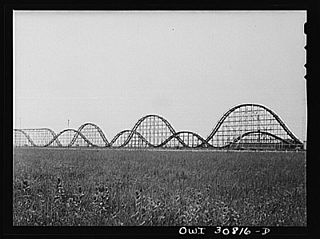
Playland Park was an amusement park located in Houston, Texas operating between 1940 and 1967. Louis Slusky opened Playland Park in 1940 at 9200 South Main. It is remembered for its wooden roller coaster, Giant Skyrocket. Texas' first elevated monorail train briefly operated near the park. Next to the park was an adjoining stock-car racetrack known as Playland Speedway. Playland Park closed in 1967.

















